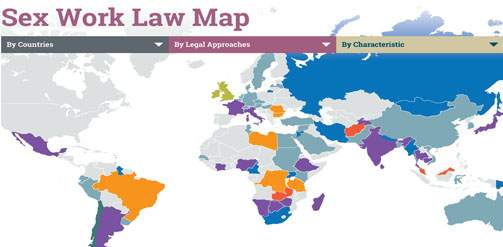Originally published on IDS in 2015. Available at: http://www.ids.ac.uk/news/vital-new-resource-on-sex-work-law-will-help-sex-workers-globally-to-realise-their-rights
A new Sex Work Law Map, developed by the Sexuality, Poverty and Law Programme at the Institute of Development Studies, has been launched that provides a global perspective on female sex work by displaying a detailed summary of the laws, regulations and policies in over 75 countries.
It is hoped that more accurate and comprehensive accounts of the laws governing sex work nationally and internationally will help inform public policy, advocacy strategies and law reform to achieve positive change and realise equal human rights for sex workers. The interactive Map reveals trends and information that will benefit sexuality activists, human rights defenders, those with an interest in sustainable development and public health, journalists, legal practitioners, policy analysts and academics. For example, it shows that in many countries sex work is criminalised, not by laws that mention prostitution, but by less defined laws against public disorder, vagrancy and loitering. This kind of information has important implications for those working to develop feasible reforms that will reduce the risks and challenges faced by sex workers.
Cheryl Overs, from IDS, who led the Map’s development with support from the UK’s Department of International Development, said: ‘Because law and regulation play such an important role in determining sex worker’s quality of life it is crucial that reliable information about sex work law can be accessed by the researchers, policymakers and professionals involved in planning and delivering health and welfare services to sex workers and their families. It is also crucial for sex workers themselves, especially the activists campaigning for law reform’.
Given the complex and changeable nature of the legal environment, users of the map are encouraged to submit additional information and corrections to ensure the resource is as useful and accurate as possible. After the launch, the map will continue to be added to and improved over time.
One of a kind
The Sex Work Law Map takes a unique approach. Many organisations have attempted to generate information about legal approaches to sex work by developing various models involving taxonomies and categories of sex work law. However the complex frameworks of law and regulation associated with sex work make it difficult to press into a formulaic model. Further, models that simply categorise sex work law fail to illuminate the outcomes of law enforcement which depend on the broader legal, political, economic and social settings.
How the Sex Work Law Map works
For each country, the Map provides an account of criminal law that directly addresses sex work. Where possible, information is also included about regulations and policies intended to prevent public nuisance or limit exploitation and disease. Enforcement practices are mentioned in most entries because they play a key part both in how sex workers experience the criminal justice system and in determining how and where sex work operates.The Map can also be searched for particular regulatory frameworks that shape the sex industry and influence sex workers’ lived experience and for groups of countries with similar legal approaches.
For more information, visit the Sex Work Law Map, contact us by email at spl@ids.ac.uk, or follow our updates on Twitter #sexworklaw.

